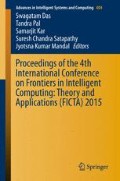Abstract
The prime objective of activity recognition is to recognize the actions performed by a person with the surrounding environment and forming different observation sets. It is necessary to choose the appropriate classifier for the data collected through accelerometer sensors incorporated in mobile phones, which have limited resources such as energy and computing power. In this paper, standard classification techniques of data mining like random forest (RF), multilayer perceptron (MLP), logistic regression, classification via regression, and J48 and RepTree have been implemented to compare the performance and accuracy of different classifiers by reducing the computational cost. In this experiment, it was found that RF required quite short time than MLP (0.64 vs. 270.07 s, respectively) to build the model and gives the better accuracy (92.6 % vs. 92.1 %, respectively). This study has concluded that RF has better performance score than other classification techniques applied in this study.
Access this chapter
Tax calculation will be finalised at checkout
Purchases are for personal use only
References
Pantelopoulos, A., Bourbakis, N.G.: A survey on wearable sensor-based systems for health monitoring and prognosis. IEEE Trans. Syst. Man Cyber.-Part C: Appl. Rev. 40, 1–12 (2010)
Davies, N., Siewiorek, D.P., Sukthankar, R.: Activity-based computing. IEEE Pervasive Comput. 7, 20–21 (2008)
Krause, A., Smailagic, A., Siewiorek, D.: Context-aware mobile computing: learning context-dependent personal preferences from a wearable sensor array. IEEE Trans. Mobile Comput. 5, 113–127 (2006)
Poppe, R.: Vision-based human motion analysis: an overview. Comput. Vis. Image Underst. 108, 4–18 (2007)
Lukowicz, P., Ward, J.A., Junker, H., Stager, M., Troster, G., Atrash, A., Starner, T.: Recognizing workshop activity using body worn microphones and accelerometers. In: Proceedings of the 2nd International Conference on Pervasive Computing, pp. 18–22 (2004)
Karantonis, D.M., Narayanan, M.R., Mathie, M., Lovell, N.H., Celler, B.G.: Implementation of a real-time human movement classifier using a triaxial accelerometer for ambulatory monitoring. IEEE Trans. Inf. Technol. Biomed. 10, 156–167 (2006)
Bao, L., Intille, S.: Activity recognition from user-annotated acceleration data. Lect. Notes Comput. Sci. 3001, 1–17 (2004)
Kwapisz, J.R., Weiss, G.M., Moore, S.A.: Activity recognition using cell phone accelerometers. In: Proceedings of the 4th International Workshop on Knoweldge Discovery from Sensor Data, Washington DC, pp. 10–18 (2010b)
Krishnan, N., Colbry, D., Juillard, C., Panchanathan, S.: Real time human activity recognition using tri-axial accelerometers. In: Sensors, Signals and Information Processing Workshop (2008)
Krishnan, N., Panchanathan, S.: Analysis of low resolution accelerometer data for continuous human activity recognition. In: IEEE International Conference on Acoustics, Speech and Signal Processing (ICASSP 2008), pp. 3337–3340 (2008)
Tapia, E.M., Intille, S.S., et al.: Real-Time recognition of physical activities and their intensities using wireless accelerometers and a heart rate monitor. In: Proceedings of the 11th IEEE International Symposium on Wearable Computers, pp. 1–4 (2007)
Mannini, A., Sabatini, A.M.: Machine learning methods for classifying human physical activity from on body accelerometers. Sensors 10, 1154–1175 (2010)
Foerster, F., Fahrenberg, J.: Motion pattern and posture: correctly assessed by calibrated accelerometers. Behav. Res. Methods Instrum. Comput. 32 (2000)
Parkka, J., Ermes, M., Korpipaa, P., Mantyjarvi, J., Peltola, J., Korhonen, I.: Activity classification using realistic data from wearable sensors. IEEE Trans. Inf. Technol. Biomed. 10, 119–128 (2006)
Lee, S.-W., Mase, K.: Activity and location recognition using wearable sensors. IEEE Pervasive Comput. 1, 24–32 (2002)
Nishkam, R., Nikhil, D., Preetham, M., Littman, M.L.: Activity recognition from accelerometer data. In: Proceedings of the Seventeenth Conference on Innovative Applications of Artificial Intelligence, pp. 1541–1546 (2005)
Kwapisz, J.R., Weiss, G.M., Moore, S.A.: Activity recognition using cell phone accelerometers. SIGKDD Explor. Newslett. 12, 74–82 (2011)
Cheverst, K., Davies, N., Mitchell, K., Friday, A., Efstratiou, C.: Developing a context-aware electronic tourist guide: some issues and experiences. 2, 17–24 (2000)
Thurau, C., Hlavac, V.: Pose primitive based human action recognition in videos or still images. In: Proceedings of the 2008 IEEE Conference on Computer Vision and Pattern Recognition, pp. 1–8 (2008)
Wu, O.W.H., Bui, A.T., Batalin, M., Au, L.K., Binney, J.D., Kaiser, W.J.: MEDIC: medical embedded device for individualized care. Artif. Intell. Med. 42, 137–152 (2008)
Fahriddin, M., Song, M.G., Kim, J.Y., Na, S.Y.: Human Activity Recognition Using New Multi-Sensor Module in Mobile Environment (2011)
Deng, W.-Y., Zheng, Q.-H., Wang, Z.-M.: Cross-person activity recognition using reduced kernel extreme learning machine. Neural Netw. (2014)
Author information
Authors and Affiliations
Corresponding author
Editor information
Editors and Affiliations
Rights and permissions
Copyright information
© 2016 Springer India
About this paper
Cite this paper
Dash, Y., Kumar, S., Patle, V.K. (2016). A Novel Data Mining Scheme for Smartphone Activity Recognition by Accelerometer Sensor. In: Das, S., Pal, T., Kar, S., Satapathy, S., Mandal, J. (eds) Proceedings of the 4th International Conference on Frontiers in Intelligent Computing: Theory and Applications (FICTA) 2015. Advances in Intelligent Systems and Computing, vol 404. Springer, New Delhi. https://doi.org/10.1007/978-81-322-2695-6_12
Download citation
DOI: https://doi.org/10.1007/978-81-322-2695-6_12
Published:
Publisher Name: Springer, New Delhi
Print ISBN: 978-81-322-2693-2
Online ISBN: 978-81-322-2695-6
eBook Packages: EngineeringEngineering (R0)

